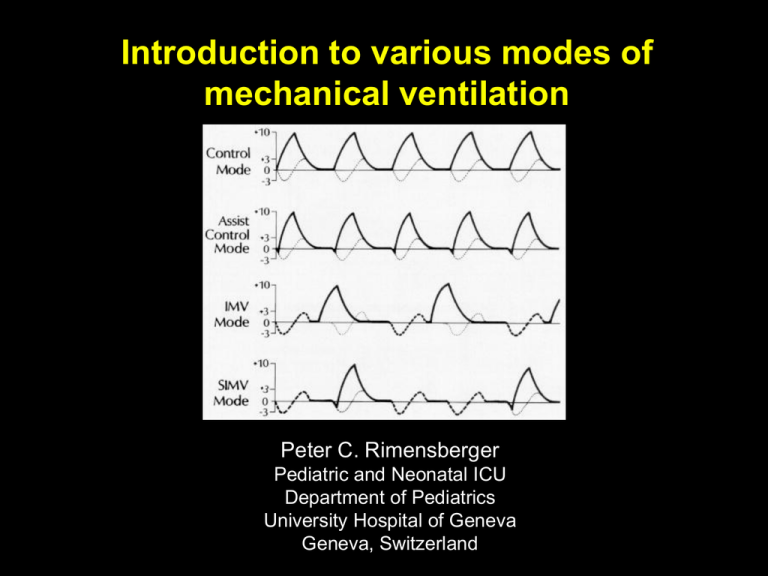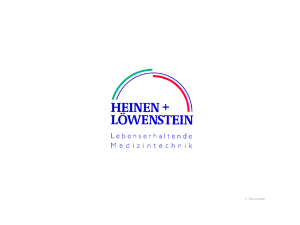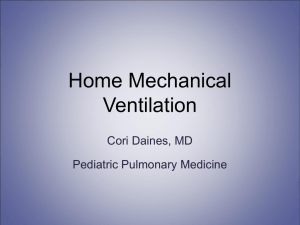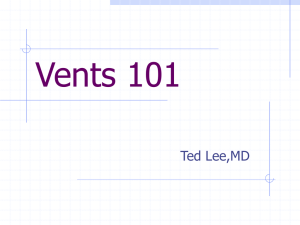2) Various ventilator modes
advertisement

Introduction to various modes of mechanical ventilation Peter C. Rimensberger Pediatric and Neonatal ICU Department of Pediatrics University Hospital of Geneva Geneva, Switzerland APRV Airway pressure release ventilation ASB Assisted spontaneous breathing ASV assisted spontaneous ventilation ASV Adaptive support ventilation ASV assisted spontaneous ventilation. ATC Automatic tube compensation Automode Automode BIPAP Bilevel Positive Airway Pressure CMV Continuous mandatory ventilation CPAP Continuous positive airway pressure CPPV Continuous positive pressure ventilation EPAP Expiratory positive airway pressure HFV High frequency ventilation HFFI High frequency flow interruption HFJV High frequency jet ventilation HFOV High frequency oscillatory ventilation HFPPV High frequency positive pressure ventilation ILV Independent lung ventilation IPAP Inspiratory positive airway pressure IPPV Intermittent positive pressure ventilation IRV Inversed ratio ventilation LFPPV Low frequency positive pressure ventilation MMV Mandatory minute volume NAVA Neurally Adjusted Ventilatory Assist NIF Negative inspiratory NIV Non-invasive ventilation PAP Positive airway pressure PAV and PAV+ Proportional assist ventilation and proportional assist ventilation plus PCMV (P-CMV) Pressure controlled mandatory ventilation PCV Pressure controlled ventilation or PC Pressure control PEEP Positive end-expiratory pressure PNPV Positive negative pressure ventilation PPS Proportional pressure support PRVC Pressure regulated volume controlled ventilation PSV Pressure Support Ventilation or PS (S) IMV (Synchronized) intermittent mandatory ventilation S-CPPV Synchronized continuous positive pressure ventilation S-IPPV Synchronized intermittent positive pressure ventilation TNI Therapy with nasal insufflation VCMV (V-CMV) Volume controlled mandatory ventilation Concepts and Modes of Mechanical Ventilation Bivent Pressure Pressure SIMV Pressure CMV Mechanical Ventilation Time Time CPAP Pressure APRV Pressure Time Time Time Spontaneous Breathing Ventilation modes Controlled: CMV Fully or partially assisted: SIMV SIPPV A/C / PTV PSV SIMV + PSV SIPPV + PSV CMV Control Modes – every breath is fully supported by the ventilator – in classic control modes, patients were unable to breathe except at the controlled set rate – in newer control modes, machines may act in assist-control, with a minimum set rate and all triggered breaths above that rate also fully supported. IMV Ingento EP & Drazen J: Mechanical Ventilators, in Hall JB, Scmidt GA, & Wood LDH(eds.): Principles of Critical Care SIPPV (or PTV or A/C) and SIMV Terminology: Triggered ventilation can be divided into patient triggered (PTV), otherwise known as synchronous intermittent positive pressure ventilation (SIPPV) or assist control (A/C), the infant being able to trigger a positive pressure inflation with each breath, and synchronized intermittent mandatory ventilation (SIMV), the infant being able to trigger only a pre-set number of positive pressure inflations. Assist-control Ingento EP & Drazen J: Mechanical Ventilators, in Hall JB, Scmidt GA, & Wood LDH(eds.): Principles of Critical Care SIMV Ingento EP & Drazen J: Mechanical Ventilators, in Hall JB, Scmidt GA, & Wood LDH(eds.): Principles of Critical Care IMV, SIMV, SIPPV (or A/C or PTV), PSV IMV SIMV Assist/Control Does the mode make the difference? SIMV versus IMV in neonatal ventilation Conclusions: We found that SIMV was at least as efficacious as conventional IMV, and may have improved certain outcomes in BW-specific groups. Bernstein G et al. J PEDIATR 1996;128:453-63 PTV (A/C) versus IMV Baumer JH Arch Dis Child Fetal Neonatal Ed 2000;82:F5–F10 PTV with inspiratory times of between 0.2 and 0.25 seconds, the ventilator set to trigger at each inspiratory effort, backup rate of 35 breaths a minute. IMV with ventilator rates set initially at between 40 and 65 breaths a minute … and initial inspiratory times between 0.2 and 0.6 seconds. PTV (A/C) versus IMV Baumer JH Arch Dis Child Fetal Neonatal Ed 2000;82:F5–F10 There was no observed benefit from the use of PTV, with a trend towards a higher rate of pneumothorax under 28 weeks of gestation. Although PTV has a similar outcome to IMV for treatment of RDS in infants of 28 weeks or more gestation, within 72 hours of birth, it was abandoned more often. It cannot be recommended for infants of less than 28 weeks’ gestation with the ventilators used in this study. Greenough A et al. Cochrane Database of Systematic Reviews 2004, Issue 3. CD000456. IMV, SIMV, SIPPV (or A/C or PTV), PSV IMV Assist/Control SIMV PSV FSV Pressure Control vs. Pressure Support Constant insp. pressure Decelerating, variable inspiratory flow rate Pressure Time cycled: (A) • Pressure Control Flow cycled: (B) • Pressure Support Flow Time Cycled Flow Cycled A B Termination Sensitivity = Cycle-off Criteria Flow Peak Flow (100%) TS 5% Leak Time Tinsp. (eff.) Set (max) Tinsp. PSV improves respiratory function in VLBW infants when compared to SIMV Migliori C et al. Pediatr Pulmonol. 2003;35:364–367 SIMV versus SIMV + PSV minimal ventilator settings: PIP 16 cm H2O FIO2 0.30 PEEP 5 cmH2O SIMV rate 15 breaths per minute and remained on these settings for 48 hours Reyes ZC et al. Pediatrics 2006;118;1409-1417 SIMV versus SIMV + PSV Reyes ZC et al. Pediatrics 2006;118;1409-1417 CONCLUSIONS. The results of this study suggest that the addition of PS as a supplement to SIMV during the first 28 days may play a role in reducing the duration of mechanical ventilation in extremely VLBW infants, and it may lead to a reduced oxygen dependency Compliance Changes During Pressure Controlled Ventilation Compliance Volume Pressure Volume Ventilation Tidal volume, is not affected by the rapidly changing pulmonary mechanics Compliance Pressure Ventilation: Volume Ventilation: Decreased Tidal Volume Increased Pressure Volume Volume Pressure Pressure Combination “Dual Control” Modes Combination or “dual control” modes combine features of pressure and volume targeting to accomplish ventilatory objectives which might remain unmet by either used independently. Combination modes are pressure targeted Partial support is generally provided by pressure support Full support is provided by Pressure Control Combination “Dual Control” Modes Concept: Assured Volume Ventilation at the lowest Pressure - Pressure Regulated Volume Control - Autoflow - Volume Guarantee - Volume Targeted Ventilation PRVC, VG, Autoflow, VTV A control mode, which delivers a set tidal volume with each breath at the lowest possible peak pressure. Delivers the breath with a decelerating flow pattern that is thought to be less injurious to the lung…… “the guided hand”. Volume Guarantee: New Approaches in Volume Controlled Ventilation for Neonates. Ahluwalia J, Morley C, Wahle HG. Dräger Medizintechnik GmbH. ISBN 3-926762-42-X Decelerating inspiratory flow pattern (square wave pressure build up) Flow Pressure Pressure automatically adjusted according respiratory mechanics to deliver set tidal volume Volume PRVC Set tidal volume © Charles Gomersall 2003 VTV Automatically Adjusts To Compliance Changes Is VTV safe? Compliance increase Draeger Babylog 8000+ Draeger Evita XL Hamilton Galileo Siemens Servo-i Bird VipGold Term infant settings Vt (ml) 50 40 30 set Vt = 28 ml 20 10 0 1 6 11 16 21 26 number of breaths Resistance decrease (500 to 50 cmH2O/lt/s) Term infant settings Vt (ml) 70 Draeger Babylog 8000+ Draeger Evita XL Hamilton Galileo Siemens Servo-i Bird VipGold 60 50 40 30 set Vt = 28 ml 20 10 0 1 Jaecklin T et al. ICM 2007 6 11 16 number of breaths 21 26 Is VTV safe? Compliance increase Compliance increase Term infant settings Preterm infant settings Vt (ml) 50 Vt (ml) 40 40 35 30 30 20 10 25 20 Draeger Babylog 8000+ Draeger Evita XL Hamilton Galileo Siemens Servo-i Draeger Babylog 8000+ Bird VipGold Draeger Evita XL Hamilton Galileo Siemens Servo-i set Vt = 28 ml Bird VipGold 15 10 set Vt = 8 ml 5 0 0 1 1 66 1111 16 1621 26 21 31 26 36 number of breaths number of breaths Resistance decrease (500 to 50 cmH2O/lt/s) Preterm infant setting Vt (ml) 20 18 16 14 12 10 8 6 4 2 0 1 Jaecklin T et al. ICM 2007 Draeger Babylog 8000+ Draeger Evita XL Hamilton Galileo Siemens Servo-i Bird VipGold set Vt = 8 ml 6 11 16 21 26 number of breaths 31 36 Advantages of volume targeted ventilation A significant increase in lung compliance, such as following exogenous surfactant administration will lead to a proportional increase in delivered VT unless the inflating pressure is reduced As the VT increases due to improving compliance after surfactant administration, the ventilator automatically drops the PIP. Volume Guarantee: New Approaches in Volume Controlled Ventilation for Neonates. Ahluwalia J, Morley C, Wahle HG. Dräger Medizintechnik GmbH. ISBN 3-926762-42-X PRCV: Advantages Decelerating inspiratory flow pattern Pressure automatically adjusted for changes in compliance and resistance within a set range Tidal volume guaranteed Limits volutrauma Prevents hypoventilation PRVC: Disadvantages Pressure delivered is dependent on tidal volume achieved on last breath Volume Flow Pressure Intermittent patient effort variable tidal volumes Set tidal volume © Charles Gomersall 2003 PRVC: Disadvantages Pressure delivered is dependent on tidal volume achieved on last breath Volume Flow Pressure Intermittent patient effort variable tidal volumes Set tidal volume © Charles Gomersall 2003 Volume Targeted Ventilation p < 0.001 Concept: deliver the set Vt at the lowest airway pressure possible p < 0.001 Cheema IU Pediatrics 2001;107:1323–1328 Volume Targeted Ventilation Cheema IU Pediatrics 2001;107:1323–1328 IL-8 IL-6 TNFa Lista G Pediatr Pulmonol. 2004; 37:510–514 Volume targeted ventilation: A Self Weaning Mode Methods: ? PSV group: The weaning strategy consisted of reducing the pressure support level progressively over time, so that the work of breathing was shifted from ventilator to the patient. PSV-VG group: Weaning was a more automatic process once appropriate levels of Vt had been established. Similar blood gas goals (e.g., pH>7.25; pO2, 50–75 mmHg; pCO2, 40–65 mmHg) were achieved during weaning from mechanical ventilation in both groups. Outcome VTV: Death in Hospital The Cochrane Library 2007, Outcome VTV: Duration of mechanical ventilation The Cochrane Library 2007, Issue 1 Pressure-Regulated Volume Control Ventilation vs. Synchronized Intermittent Mandatory Ventilation for Very Low-Birth-Weight Infants D’Angio CT et al. Arch Pediatr Adolesc Med. 2005;159:868-875 Pressure-Regulated Volume Control Ventilation vs. Synchronized Intermittent Mandatory Ventilation for Very Low-Birth-Weight Infants Conclusion: In mechanically ventilated infants with birth weights of 500 to 1249 g, using PRVC ventilation from birth did not alter time to extubation. D’Angio CT et al. Arch Pediatr Adolesc Med. 2005;159:868-875 A total of 24 RCTs and 3 systematic reviews comparing various CMV modes and settings and 2 RCTs investigating permissive hypercapnia reported no differences in mortality or bronchopulmonary dysplasia.









